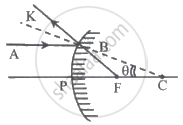Advertisements
Advertisements
Question
Answer the following question in detail.
How does magnifying power differ from linear or lateral magnification?
Solution
- The linear magnification is the ratio of the size of the image to the size of the object.
- When the distances of the object and image formed are very large as compared to the focal lengths of the instruments used, the magnification becomes infinite. Whereas, the magnifying power is the ratio of the angle subtended by the object and image, gives the finite value.
- For example, in the case of a compound microscope,
Mmin = `"D"/"f"=25/5` = 5 and Mmax = `1+"D"/"f"` = 6
Hence image appears to be only 5 to 6 times bigger for a lens of focal length 5 cm.
For Mmin = `"D"/"f"` = 5, v = ∞
∴ Lateral magnification (m) = `"v"/"u"` = ∞
Thus, the image size is infinite times that of the object but appears only 5 times bigger.
APPEARS IN
RELATED QUESTIONS
Answer the following question in detail.
What is a terrestrial telescope and an astronomical telescope?
Answer the following question in detail.
Obtain the expressions for magnifying power and the length of an astronomical telescope under normal adjustments.
Answer the following question in detail.
What is the limitation in increasing the magnifying powers of a compound microscope?
What is the near point focusing?
What is the use of an erecting lens in a terrestrial telescope?
What is the use of collimator in a spectrmeter?
What are the uses of spectrometer?
What is myopia?
What is the remedy of myopia?
What is hypermetropia?
Obtain the equation for resolving the power of the microscope.
Discuss about astronomical telescope.
Mention different parts of the spectrometer.
Explain the preliminary adjustments of the spectrometer.
Explain the experimental determination of the material of the prism using a spectrometer.
A compound microscope has a magnifying power of 100 when the image is formed at infinity. The objective has a focal length of 0.5 cm and the tube length is 6.5 cm. What is the focal length of the eyepiece.
A light wave of wavelength λ is incident on a slit of width d. The resulting diffraction pattern is observed on a screen at a distance D. If linear width of the principal maxima is equal to the width of the slit, then the distance D is
If astronomical telescope of length 1.53 m has magnifying power of magnitude 50, the values of fo and fe are ____________.
The magnifying power of a telescope is high if its objective and eyepiece have respectively ______.
A simple microscope is used to see the object first in blue light and then in red light. Due to the change from blue to red light, what is the effect on its magnifying power?
An object viewed from a near point distance of 25 cm, using a microscopic lens with magnification '6', gives an unresolved image. A resolved image is observed at infinite distance with a total magnification double the earlier using an eyepiece along with the given lens and a tube of length 0.6 m, if the focal length of the eyepiece is equal to ______ cm.
Magnification produced by astronomical telescope for normal adjustment is 10 and length of telescope is 1.1 m. The magnification when the image is formed at least distance of distinct vision (D = 25 cm) is ______.
An observer looks at a distant tree of height 10 m with a telescope of magnifying power of 20. To the observer the tree appears:
In the adjoining figure, AB represents the incident ray, and BK is the reflected ray. If angle BCF = θ, then ∠BFP is given by ______.

